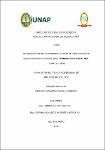Determinación de la densidad óptima de cría larval de Brycon amazonicus (Agassiz, 1829) "sábalo cola roja" IIAP - Loreto - Perú
Abstract
The study was carried out in the facilities of the Research Institute of the Peruvian Amazon (IIAP), located at km 4.5 of the Iquitos - Nauta highway, province of Maynas, department of Loreto. The optimal density of larval breeding of Sabalo cola roja Brycon amazonicus was determined, through three densities evaluating growth and survival, which were cultivated in glass tanks for 15 days. 3 treatments with three repetitions were used, having a total of 9 experimental units at densities of 5 larvae/L (T1), 10 larvae/L (T2) and 15 larvae/L (T3). The larvae were placed in fish tanks of 30x30x40 cm, a total of 1800 larvae were planted with initial weight and initial average length of 0.1g and 0.7cm. They were fed ad libitum with artemia nauplii as the only food, with four feeding frequencies per day (at 8, 11, 14 and 17 hours). The data obtained during the experimental period in weight and height were 1.87±0.37g and 2.5±0.2cm for T1, 1.79±0.22g and 2.5±0.1cm for T2, and 1.80±0.35g and 2.5±0.1cm for T3, with no significant difference in growth (P>0.05); however, in survival there was a significant difference (P<0.05) where T2 had a better result with 17.2% compared to T1 and T3, which were 12% and 10.1% respectively. The physical and chemical parameters of the water quality were within what is recommended for the cultivation of post larvae of Sabalo cola roja. El estudio se desarrolló en las instalaciones del Instituto de Investigaciones de la Amazonía Peruana, situado en el km 4.5 de la carretera Iquitos - Nauta, provincia de Maynas, departamento de Loreto. Se determinó la densidad óptima de cría larval de sábalo cola roja Brycon amazonicus, a través de tres densidades evaluando el crecimiento y supervivencia, los cuales fueron cultivados en peceras de vidrio durante 15 dias, se utilizaron 3 tratamientos con tres repeticiones, teniendo un total de 9 unidades experimentales a densidades de 5 larvas/L (T1), 10 larvas/L (T2) y 15 larvas/L (T3), las larvas fueron colocadas en peceras de 30x30x40 cm, se sembraron un total de 1800 larvas con peso y longitud promedio inicial de 0.1g y 0.7cm. Fueron alimentadas ad libitum con nauplios de artemia como único alimento, con cuatro frecuencias de alimentación al día (a las 8, 11, 14 y 17 horas). Los datos obtenidos durante el periodo experimental en peso y talla fueron 1.87±0.37g y 2.5±0.2cm para T1, 1.79±0.22g y 2.5±0.1cm para el T2 y 1.80±0.35g y 2.5±0.1cm para el T3, no registrando diferencia significativa en el crecimiento (P>0.05); sin embargo, en la supervivencia se registró diferencia significativa (P<0.05) donde el T2 tuvo un mejor resultado con 17.2% en comparación con T1 y T3, los cuales fueron 12% y 10.1% respectivamente. Los parámetros físicos y químicos de la calidad de agua, estuvieron dentro de lo recomendable para el cultivo de post larvas de Sábalo cola roja.
Collections
- Tesis [145]


